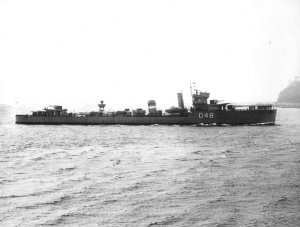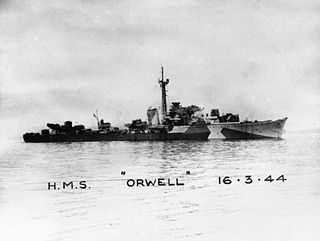Related Research Articles

HMS Vidette (D48) was an Admiralty V-class destroyer of the Royal Navy. Built at the end of the First World War, she served in the final months of that conflict, and saw extensive service in the inter war years and in World War II. She was an effective convoy escort and U-boat killer, being credited with the destruction of five U-boats during the Battle of the Atlantic. HMS Vidette transported Spike Island Republican Prisoners to Bere Island Internment Camp in 1921. *Refer Spike Island’s Republican Prisoners, 1921 by Tom O’Neill MA.

The first USS Twiggs (DD–127) was a Wickes-class destroyer in the United States Navy during World War I. She was named for Major Levi Twiggs. She was later transferred to the Royal Navy, as HMS Leamington and to the Soviet Navy as Zhguchy, before returning to Britain to star in the film The Gift Horse, which depicts the St. Nazaire Raid.

HMS Orwell was an O-class destroyer of the Royal Navy that entered service in 1942 and was broken up in 1965.

HMS Balfour was a Captain-class frigate of the Royal Navy which served during World War II. She was built as a TE (Buckley) type destroyer escort in the United States and delivered to the Royal Navy under the Lend-Lease arrangement.
HMS Marigold was a Flower-class corvette of the Royal Navy. She was launched on 4 September 1940 and was sunk by an Italian air-dropped torpedo on 9 December 1942.
Convoy SC 42 was the 42nd of the numbered series of World War II Slow Convoys of merchant ships from Sydney, Cape Breton Island to Liverpool. SC 42 was attacked over a three night period in September 1941, losing 16 ships sunk and 4 damaged. This was the worst Allied loss following the attack on convoy SC 7 the previous year. Two attacking U-boats were destroyed.

Convoy SC 130 was a North Atlantic convoy which ran during the battle of the Atlantic in World War II. It was the 130th of the numbered series of Slow Convoys of merchant ships from Sydney, Cape Breton Island to Liverpool. SC 130 was one of several convoy battles that occurred during the crisis month of May 1943.

Convoy SC 104 was the 104th of the numbered series of World War II Slow Convoys of merchant ships from Sydney, Cape Breton Island to Liverpool. During October 1942, a U-boat wolf pack sank eight ships from the convoy. The convoy escorts sank two of the attacking submarines.

Mid-Ocean Escort Force (MOEF) referred to the organisation of anti-submarine escorts for World War II trade convoys between Canada and Newfoundland, and the British Isles. The allocation of United States, British and Canadian escorts to these convoys reflected preferences of the United States upon United States' declaration of war and the organisation persisted through the winter of 1942–43 despite withdrawal of United States ships from the escort groups. By the summer of 1943, United States Atlantic escorts were focused on the faster CU convoys and the UG convoys between Chesapeake Bay and the Mediterranean Sea; and only British and Canadian escorts remained on the HX, SC and ON convoys.
ONS 20 and ON 206 were North Atlantic convoys of the ONS/ON series which ran during the battle of the Atlantic in World War II. They were the subject of a major U-boat attack in October 1943, the third battle in the Kriegsmarine's autumn offensive.

HMS Wrestler (D35) was a V and W-class destroyer built by the Royal Navy during the First World War and active from 1939 to 1944 during the Second World War. She was the first Royal Navy ship to bear that name, and the only one to do so to date.

Donald George Frederick Wyville Macintyre DSO & Two Bars, DSC was a Royal Navy officer during the Second World War and a successful convoy escort commander. Following the war, he was an author of numerous books on British naval history.
Escort Group B7 was a British formation of the Royal Navy which saw action during the Second World War; principally in the Battle of the Atlantic.
36th Escort Group was a British formation of the Royal Navy which saw action during the Second World War, principally in the Battle of the Atlantic. The group operated mainly on the Gibraltar and South Atlantic convoy routes and was involved in several convoy battles, including Convoy HG 76, one of the first Allied victories in the Atlantic campaign.
Escort Group B6 was a British convoy escort group of the Royal Navy which saw action during the Second World War, principally in the Battle of the Atlantic.

Convoy JW 51A was an Arctic convoy sent from Great Britain by the Western Allies to aid the Soviet Union during World War II. It sailed in December 1942, reaching the Soviet northern ports at the end of the month. Convoy JW 51A was not detected or attacked by German forces and arrived without loss.

Convoy JW 51B was an Arctic convoy sent from United Kingdom by the Western Allies to aid the Soviet Union during the Second World War. It sailed in late December 1942, reaching the Soviet northern ports in early January 1943.
SC 129 was a North Atlantic convoy of the SC series which ran during the Battle of the Atlantic in World War II. It was one of several convoy battles that occurred during the crisis month of May 1943.

Arctic naval operations of World War II were the World War II naval operations that took place in the Arctic Ocean, and can be considered part of the Battle of the Atlantic and/or of the European Theatre of World War II.

HMS Godetia was the second Flower-class corvette with that name built for the Royal Navy. She served during the Second World War as part of the Section Belge of the Royal Navy (RNSB). With the liberation of Belgium in late 1944, the vessel was returned to the United Kingdom. In common with other Flower-class corvettes, the ship was named after an eponymous flower.
References
- Blair, Clay (1998). Hitler's U-Boat War: The Hunted 1942–1945. ISBN 0-304-35261-6.
- Kemp, Paul (1997). U-Boats Destroyed, German submarine losses in the World Wars. Arms and Armour. ISBN 1-85409-515-3.
- Macintyre, Donald (1956). U-Boat Killer. London: Weidenfeld and Nicolson. OCLC 1547547.
- Niestle, Axel (1998). German U-Boat Losses During World War II. Greenhill. ISBN 1-85367-352-8.
- Roskill, Stephen (1960). The War at Sea 1939–1945: The Offensive, Part 1, 1st June 1943 – 31st May 1944. Vol. III. London: HMSO. OCLC 916211985.
- Rohwer, Jürgen; Hümmelchen, Gerhard (2005) [1972]. Chronology of the War at Sea, 1939–1945: The Naval History of World War Two (3rd rev. ed.). London: Chatham. ISBN 978-1-86176-257-3.